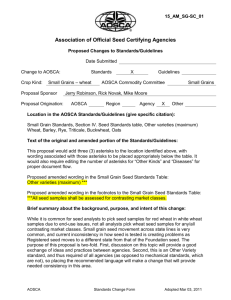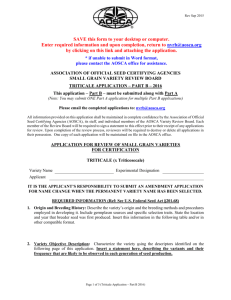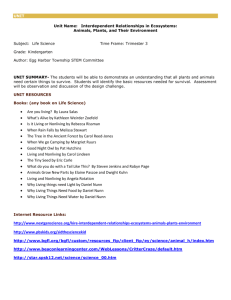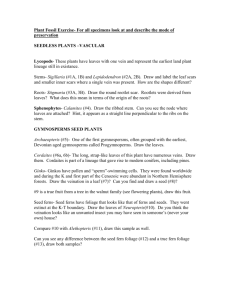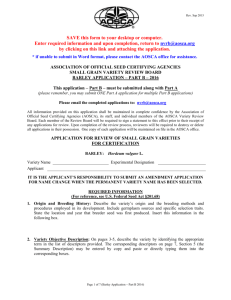2016 Small Grains Application - Part B - Wheat
advertisement
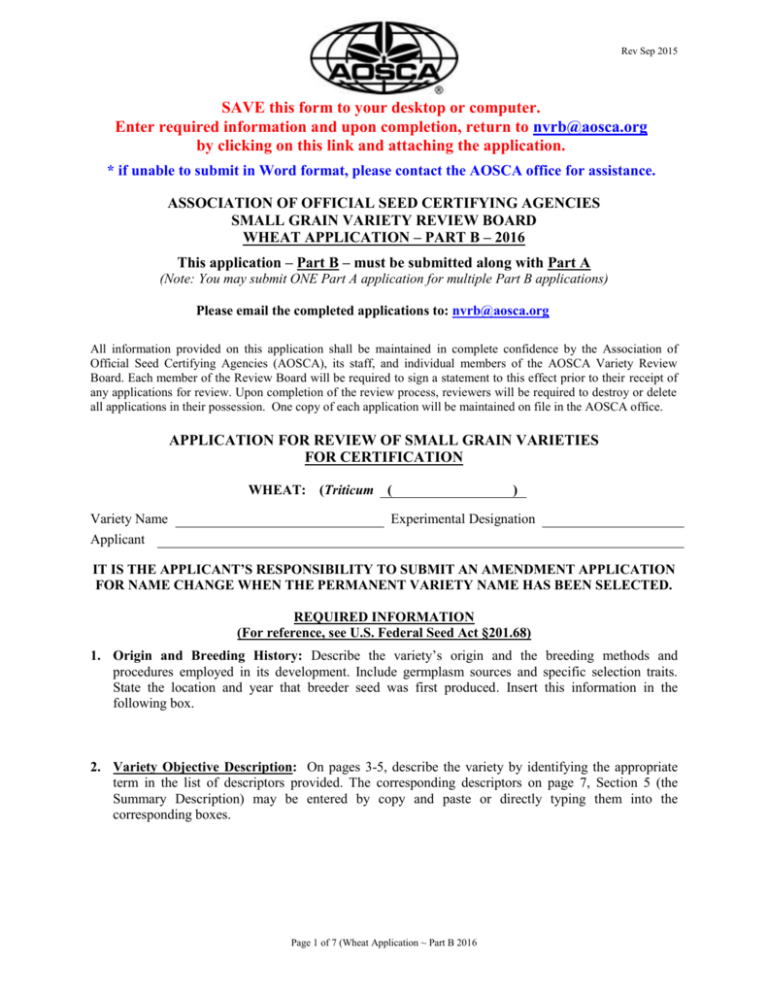
Rev Sep 2015 SAVE this form to your desktop or computer. Enter required information and upon completion, return to nvrb@aosca.org by clicking on this link and attaching the application. * if unable to submit in Word format, please contact the AOSCA office for assistance. ASSOCIATION OF OFFICIAL SEED CERTIFYING AGENCIES SMALL GRAIN VARIETY REVIEW BOARD WHEAT APPLICATION – PART B – 2016 This application – Part B – must be submitted along with Part A (Note: You may submit ONE Part A application for multiple Part B applications) Please email the completed applications to: nvrb@aosca.org All information provided on this application shall be maintained in complete confidence by the Association of Official Seed Certifying Agencies (AOSCA), its staff, and individual members of the AOSCA Variety Review Board. Each member of the Review Board will be required to sign a statement to this effect prior to their receipt of any applications for review. Upon completion of the review process, reviewers will be required to destroy or delete all applications in their possession. One copy of each application will be maintained on file in the AOSCA office. APPLICATION FOR REVIEW OF SMALL GRAIN VARIETIES FOR CERTIFICATION WHEAT: (Triticum ( Variety Name Applicant ) Experimental Designation IT IS THE APPLICANT’S RESPONSIBILITY TO SUBMIT AN AMENDMENT APPLICATION FOR NAME CHANGE WHEN THE PERMANENT VARIETY NAME HAS BEEN SELECTED. REQUIRED INFORMATION (For reference, see U.S. Federal Seed Act §201.68) 1. Origin and Breeding History: Describe the variety’s origin and the breeding methods and procedures employed in its development. Include germplasm sources and specific selection traits. State the location and year that breeder seed was first produced. Insert this information in the following box. 2. Variety Objective Description: On pages 3-5, describe the variety by identifying the appropriate term in the list of descriptors provided. The corresponding descriptors on page 7, Section 5 (the Summary Description) may be entered by copy and paste or directly typing them into the corresponding boxes. Page 1 of 7 (Wheat Application ~ Part B 2016 Rev Sep 2015 3. Supporting Information: Provide data to characterize the variety in the following areas. All claims made about the variety must be supported by data. a) Yield and other agronomic responses obtained from test locations that support the area of adaptation. b) Disease and insect reactions if any such reactions are stated as varietal attributes. Provide testing conditions used to determine reactions (e.g., field, greenhouse, or laboratory; identity of testing methods). State specific races or strains of organisms, if known. c) Provide evidence of quality and/or other relevant attributes if these claims are used as a means of identifying the variety. Provide data from at least two years and two locations within the area of adaptation for yield and agronomic response traits, as appropriate. Include and identify at least one recognized check variety for comparing agronomic data and for comparing milling/baking traits, if referenced. Include and identify susceptible and resistant checks for comparative pest reactions. Present all data in well-constructed tables appended to the end of this application. Number the tables and indicate where the data were collected. Include captions or footnotes as necessary to clearly explain the nature of the units of measurements used in the header. Provide the number of entries in the tests, the test grand mean, and a measure of statistical significance, such as least significant difference or multiple range comparison, for each location-year or test. 4. Summary Description: Provide a concise single-page description of the variety for AOSCA to publish for use by official seed certifying agencies. All claims must be supported by data. Use the instructions and template located at the end of this application. Consult the sample application on the AOSCA website for guidance. Page 2 of 7 (Wheat Application ~ Part B 2016 Rev Sep 2015 VARIETY OBJECTIVE DESCRIPTION WHEAT (Triticum Variety Name: Instructions: Select one (1) descriptor (except where otherwise instructed) to enter in the corresponding element on the Summary Description page (see page 7). If “Other” is selected, state what it is. 1. KIND OF WHEAT: Common Durum Emmer Polish Poulard Spelt Club If Common, state kernel characteristics in Item 5.1 on page 7. Example: Hard red common, and place an “X” in the appropriate selection below. Hard Red Soft Red Hard White Soft White 2. SEASONAL GROWTH HABIT: Winter Spring Other 3. COLEOPTILE COLOR: White Red Other 4. JUVENILE GROWTH HABIT: Prostrate Semi-Erect Erect 5. LEAF COLOR AT BOOT: Yellow-Green Green Blue-Green Gray-Blue 6. FLAG LEAF AT BOOT: (Multiple descriptors may be selected) Erect Re-curved Twisted Not-Twisted Wax Absent Wax Present 7. AURICLE COLOR: White Purple Other 8. HEADING DATE / ANTHESIS: Average number of day(s) to 50% heading This averages than Day(s) Earlier Later (known variety) Page 3 of 7 (Wheat Application ~ Part B 2016 (select one, using X) Rev Sep 2015 9. ANTHER COLOR: Yellow Purple STEM CHARACTERISTICS 10. ANTHOCYANIN: Absent Present 11. PLANT HEIGHT: Average number in centimeters: (insert height in Item 5.11 of Summary Description, page 7) This averages cm TALLER cm SHORTER than (select one, using X) (known variety) 12. INTERNODES: Hollow Solid Semi-solid SPIKE CHARACTERISTICS (at maturity) 13. SHAPE: Tapering Oblong Clavate Elliptical 14. DENSITY: Lax Mid Dense Dense 15. CURVATURE (Orientation at maturity): Erect Inclined Nodding 16. AWNS: Awnless Apically awnletted Awnletted 17. AWN COLOR: White Black Brown Tan GLUME CHARACTERISTICS (at maturity) 18. COLOR: Tan White/Amber Other 19. LENGTH: Short Medium Long 20. SHOULDER SHAPE: Wanting Square Oblique Elevated Rounded Apiculate Page 4 of 7 (Wheat Application ~ Part B 2016 Awned Rev Sep 2015 21. SHOULDER WIDTH: Narrow Medium Wide 22. BEAK SHAPE: Acuminate Obtuse Acute 23. BEAK LENGTH: Short Medium Long Very long 24. PUBESCENCE: Present Absent (glabrous) SEED CHARACTERISTICS 25. COLOR: White Amber Red Other 26. SHAPE: Ovate Oval Elliptical 27. CHEEK: Rounded Angular 28. BRUSH: Short Medium Long 29. AVERAGE 1,000-KERNEL WEIGHT (Insert weight and X for comparison) gm. - which is: Lighter than Same as Heavier than (Known variety) 30. OTHER: List any other traits or special markers that may be helpful in identifying the variety, including characteristics determined by molecular or bioassay methods that might be required as a condition of eligibility for final certification. Page 5 of 7 (Wheat Application ~ Part B 2016 Rev Sep 2015 Summary Description: Provide a concise, single page description of the variety on the next page for 4. AOSCA to publish for use by official seed certifying agencies. All claims must be supported by data. You must use the categories described below, using COMPLETE SENTENCES. Insert your text in the blank cell next to the item number. PLEASE DELETE THIS INSTRUCTION PAGE WHEN SUBMITTING AN APPLICATION. Wheat Insert Variety Name Here Insert Experimental Designation Name(s) Here 1. The name of the variety, including its experimental designation, its market class, and the identity of the developer and/or owner. Example: Nuwheet (Experimental no.) is a hard red winter wheat developed by ABC Breeding Company. 2. A summary statement of the selection criteria and breeding procedures that were previously described. Confidential business information is not required. Example: Nuwheet was selected for high spike density, resistance to stripe rust, and high falling number using the single seed descent method. 3. Area of probable adaptation, testing locations, and primary purpose for which the variety will be used. Example: Nuwheet was tested in western Oklahoma and is well-adapted as to be a grazing-tolerant bread wheat in the irrigated and dryland production areas of the southern High Plains. 4. A statement relative to the variety’s disease and insect resistance. Example: Nuwheet is resistant to races 1, 2, 3 of stem rust and moderately resistant to Hessian fly. 5. Provide a detailed description of morphological, physiological and other identifying characteristics by selecting options presented in the Variety Objective Description section and typing or pasting the selections into the table on the Summary Description format page. Include a description of variants and their frequency at the end of the section. 6. State the certified seed classes to be recognized, the party responsible for maintaining the variety, and procedure(s) adopted for maintaining seed stocks, with limitations, if any. If applicable, state whether the variety may be subject to collection of a royalty fee by certifying agencies and whether any kind of stewardship or licensing agreement is required that would affect certifying agency activities, such as trait-verification by molecular or bioassay testing. Example: Recognized classes of Nuwheet are breeder, foundation, registered, and certified. ABC Breeding Company will maintain the variety by the head-row purification method to produce breeder seed as needed and all foundation seed. No royalty fees or licensing agreements are anticipated. 7. State the likely date that certified seed will first be offered for sale. Example: Certified seed of Nuwheet will likely be available for planting in fall of 2015 8. State whether or not application will be submitted for protection under the U.S. Plant Variety Protection Act and, if appropriate, whether or not the “Certification Option” will be elected (to be sold by variety name only as a class of certified seed). If application for PVP is not planned, state whether relevant descriptive data (morphological only) can be supplied to the PVP database. Examples: Application for PVP is anticipated with the option that Nuwheet can be sold by variety name only as a class of certified seed. OR: Application for PVP is not planned and descriptive data may be supplied to the PVP database. 9. State whether or not certified seed production acreage can be published by AOSCA and certifying agencies. Examples: Certified seed production acreage (may) (is not to) be published by AOSCA and individual certifying agencies Page 6 of 7 (Wheat Application ~ Part B 2016 Rev Sep 2015 Wheat Insert Variety Name Here Insert Experimental Designation Name(s) Here 1. 2. 3. 4. 5. Identifying characteristics – insert the descriptive term from the Objective Description (pages 3except where indicated: 1. Kind: If common, provide appropriate kernel characteristic: (Hard Red, Soft Red, Hard White, Soft White) 2. Seasonal Growth Habit: 16. Awn Type: 3. Coleoptile Color: 17. Awn Color: 4. Juvenile Growth Habit: 18. Glume Color: 5. Leaf Color at Boot: 19. Glume Length: 6. Flag Leaf at Boot: 20. Shoulder Shape: 7. Auricle Color: 21. Shoulder Width: 8. Day(s) to 50% Heading: 22. Beak Shape: 9. Anther Color: 23. Beak Length (S.M.L.VL): 10. Anthoncyanin: 24. Glume Pubescence: 11. Plant Height (cm): 25. Seed Color 12. Internodes: 26. Seed Shape: 13. Spike Shape: 27. Cheeks: 14. Spike Density: 28. Brush Size (S,M,L.): 15. Spike Curvature: 29. Avg 1,000 Kernel Wt (g): 30. Physiological/biochemical Traits: Variants and frequency: 6. 7. 8. 9. Page 7 of 7 (Wheat Application ~ Part B 2016

